
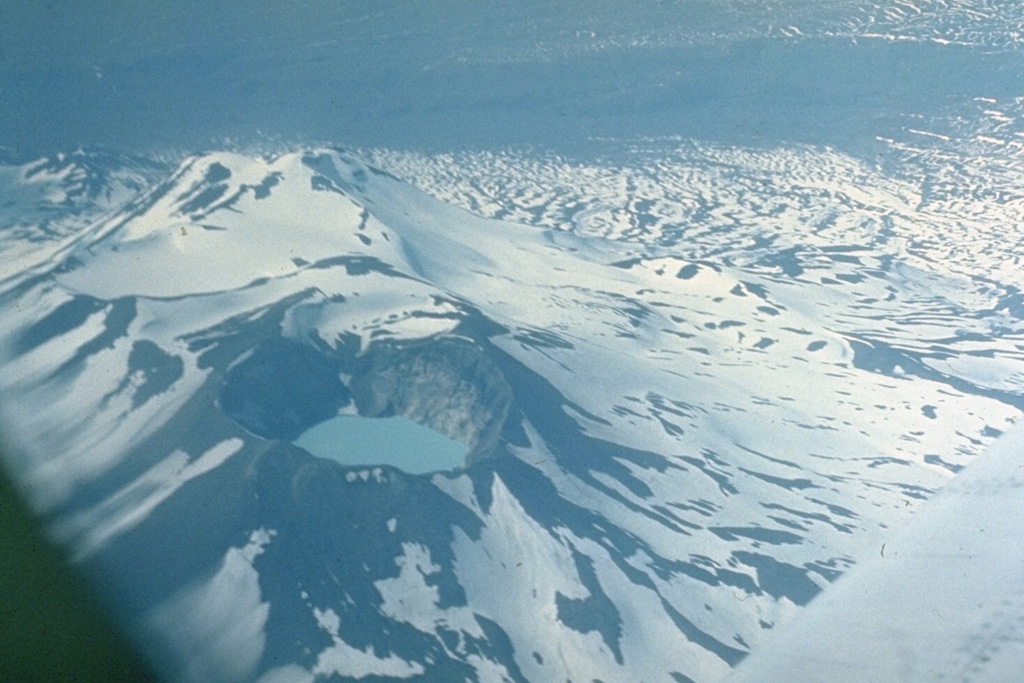
Although Maly Semyachik was not erupting, KVERT raised the Aviation Color Code to Orange (the second highest level on a four-color scale) on 28 October, noting that a plume of ash, re-suspended by strong winds, was visible in satellite images drifting 123 km SE. Within three hours the Aviation Color Code was lowered back to Green. Dates are based on UTC times; specific events are in local time where noted.
Although Maly Semyachik was not erupting, KVERT raised the Aviation Color Code to Orange (the second highest level on a four-color scale) on 28 October, noting that a plume of ash, re-suspended by strong winds, was visible in satellite images drifting 123 km SE. Within three hours the Aviation Color Code was lowered back to Green. Dates are based on UTC times; specific events are in local time where noted.
Source: Kamchatkan Volcanic Eruption Response Team (KVERT)
KVERT reported that activity at Maly Semyachik increased during the second half of March; the ice covering the crater lake melted within a 5-6-day period, and a weak thermal anomaly was visible in satellite images. The Aviation Color Code was raised to Yellow (the second lowest level on a four-color scale) on 22 March. A weak thermal anomaly continued to be detected through 20 April, though no further activity prompted KVERT to lower the Aviation Color Code to Green.
Source: Kamchatkan Volcanic Eruption Response Team (KVERT)
The Global Volcanism Program has no Bulletin Reports available for Maly Semyachik.
This compilation of synonyms and subsidiary features may not be comprehensive. Features are organized into four major categories: Cones, Craters, Domes, and Thermal Features. Synonyms of features appear indented below the primary name. In some cases additional feature type, elevation, or location details are provided.
Synonyms |
||||
| Maly Semiachik | Bolshoi Semiachik | Srezannaia Mountain | Grosse Ssemjatschik | Malaia Semiachik | Malyj Semjatschik | ||||
Cones |
||||
| Feature Name | Feature Type | Elevation | Latitude | Longitude |
| Berezovy | Stratovolcano | |||
|
Ceno-Semiachik
Kaino-Semiachik |
Stratovolcano | 1330 m | 54° 6' 51" N | 159° 39' 19" E |
| Meso-Semiachik | Stratovolcano | 1390 m | 54° 7' 18" N | 159° 40' 35" E |
| Obmanuvshy | Cone | |||
| Paleo-Semiachik | Stratovolcano | 1527 m | 54° 8' 7" N | 159° 40' 25" E |
| Stupenchaty Bastion | Stratovolcano | |||
| Sukhoi | Stratovolcano | |||
|
Yushny
Yuzhny |
Cone | |||
Craters |
||||
| Feature Name | Feature Type | Elevation | Latitude | Longitude |
| Soboliny | Caldera | 1100 m | 54° 8' 49" N | 159° 26' 22" E |
| Stena | Caldera | 814 m | 54° 4' 12" N | 159° 45' 27" E |
|
Troitsky
Troitzky |
Crater | 1200 m | 54° 7' 7" N | 159° 39' 21" E |
|
|
||||||||||||||||||||||||||||
There is data available for 23 confirmed Holocene eruptive periods.
1952 Dec 5 ± 4 days Confirmed Eruption VEI: 2
| Episode 1 | Eruption | Ceno-Semiachik (Toitsky Crater) | |||||||||||||||||||
|---|---|---|---|---|---|---|---|---|---|---|---|---|---|---|---|---|---|---|---|---|
| 1952 Dec 5 ± 4 days - Unknown | Evidence from Observations: Reported | |||||||||||||||||||
|
List of 2 Events for Episode 1 at Ceno-Semiachik (Toitsky Crater)
| ||||||||||||||||||||
1945 Sep (?) - 1946 Apr 15 ± 45 days Confirmed Eruption VEI: 2
| Episode 1 | Eruption | Ceno-Semiachik (Toitsky Crater) | ||||||||||||||||||||||||
|---|---|---|---|---|---|---|---|---|---|---|---|---|---|---|---|---|---|---|---|---|---|---|---|---|---|
| 1945 Sep (?) - 1946 Apr 15 ± 45 days | Evidence from Observations: Reported | ||||||||||||||||||||||||
|
List of 3 Events for Episode 1 at Ceno-Semiachik (Toitsky Crater)
| |||||||||||||||||||||||||
1852 Apr 15 ± 45 days - 1852 Jul Confirmed Eruption VEI: 2
| Episode 1 | Eruption | Ceno-Semiachik (Troitsky Crater) | |||||||||||||||||||
|---|---|---|---|---|---|---|---|---|---|---|---|---|---|---|---|---|---|---|---|---|
| 1852 Apr 15 ± 45 days - 1852 Jul | Evidence from Observations: Reported | |||||||||||||||||||
|
List of 2 Events for Episode 1 at Ceno-Semiachik (Troitsky Crater)
| ||||||||||||||||||||
1851 Sep Confirmed Eruption VEI: 2
| Episode 1 | Eruption | Ceno-Semiachik (Troitsky Crater) | |||||||||||||||||||
|---|---|---|---|---|---|---|---|---|---|---|---|---|---|---|---|---|---|---|---|---|
| 1851 Sep - Unknown | Evidence from Observations: Reported | |||||||||||||||||||
|
List of 2 Events for Episode 1 at Ceno-Semiachik (Troitsky Crater)
| ||||||||||||||||||||
1804 Confirmed Eruption VEI: 3
| Episode 1 | Eruption | Ceno-Semiachik (Troitsky Crater) | ||||||||||||||||||||||||||||||||||
|---|---|---|---|---|---|---|---|---|---|---|---|---|---|---|---|---|---|---|---|---|---|---|---|---|---|---|---|---|---|---|---|---|---|---|---|
| 1804 - Unknown | Evidence from Observations: Reported | ||||||||||||||||||||||||||||||||||
|
List of 5 Events for Episode 1 at Ceno-Semiachik (Troitsky Crater)
| |||||||||||||||||||||||||||||||||||
1550 (?) Confirmed Eruption VEI: 4
| Episode 1 | Eruption | Ceno-Semiachik (Crater VI--Troitsky) | ||||||||||||||||||||||||
|---|---|---|---|---|---|---|---|---|---|---|---|---|---|---|---|---|---|---|---|---|---|---|---|---|---|
| 1550 (?) - Unknown | Evidence from Isotopic: 14C (calibrated) | ||||||||||||||||||||||||
|
List of 3 Events for Episode 1 at Ceno-Semiachik (Crater VI--Troitsky)
| |||||||||||||||||||||||||
1400 ± 50 years Confirmed Eruption
| Episode 1 | Eruption | Ceno-Semiachik (Crater V) | ||||||||||||||||||||||||||||||||||
|---|---|---|---|---|---|---|---|---|---|---|---|---|---|---|---|---|---|---|---|---|---|---|---|---|---|---|---|---|---|---|---|---|---|---|---|
| 1400 ± 50 years - Unknown | Evidence from Isotopic: 14C (calibrated) | ||||||||||||||||||||||||||||||||||
|
List of 5 Events for Episode 1 at Ceno-Semiachik (Crater V)
| |||||||||||||||||||||||||||||||||||
0550 BCE (?) Confirmed Eruption
| Episode 1 | Eruption | Ceno-Semiachik | ||||||||||||||
|---|---|---|---|---|---|---|---|---|---|---|---|---|---|---|---|
| 0550 BCE (?) - Unknown | Evidence from Isotopic: 14C (calibrated) | ||||||||||||||
|
List of 1 Events for Episode 1 at Ceno-Semiachik
| |||||||||||||||
0650 BCE (?) Confirmed Eruption
| Episode 1 | Eruption | Ceno-Semiachik | ||||||||||||||
|---|---|---|---|---|---|---|---|---|---|---|---|---|---|---|---|
| 0650 BCE (?) - Unknown | Evidence from Isotopic: 14C (calibrated) | ||||||||||||||
|
List of 1 Events for Episode 1 at Ceno-Semiachik
| |||||||||||||||
0850 BCE (?) Confirmed Eruption
| Episode 1 | Eruption | Ceno-Semiachik | ||||||||||||||||||||||||
|---|---|---|---|---|---|---|---|---|---|---|---|---|---|---|---|---|---|---|---|---|---|---|---|---|---|
| 0850 BCE (?) - Unknown | Evidence from Isotopic: 14C (calibrated) | ||||||||||||||||||||||||
|
List of 3 Events for Episode 1 at Ceno-Semiachik
| |||||||||||||||||||||||||
1800 BCE ± 50 years Confirmed Eruption
| Episode 1 | Eruption | Ceno-Semiachik (SW flank) | |||||||||||||||||||
|---|---|---|---|---|---|---|---|---|---|---|---|---|---|---|---|---|---|---|---|---|
| 1800 BCE ± 50 years - Unknown | Evidence from Isotopic: 14C (calibrated) | |||||||||||||||||||
|
List of 2 Events for Episode 1 at Ceno-Semiachik (SW flank)
| ||||||||||||||||||||
2250 BCE (?) Confirmed Eruption
| Episode 1 | Eruption | Ceno-Semiachik | ||||||||||||||
|---|---|---|---|---|---|---|---|---|---|---|---|---|---|---|---|
| 2250 BCE (?) - Unknown | Evidence from Isotopic: 14C (calibrated) | ||||||||||||||
|
List of 1 Events for Episode 1 at Ceno-Semiachik
| |||||||||||||||
2450 BCE (?) Confirmed Eruption
| Episode 1 | Eruption | Ceno-Semiachik (Crater IV) | ||||||||||||||||||||||||
|---|---|---|---|---|---|---|---|---|---|---|---|---|---|---|---|---|---|---|---|---|---|---|---|---|---|
| 2450 BCE (?) - Unknown | Evidence from Isotopic: 14C (calibrated) | ||||||||||||||||||||||||
|
List of 3 Events for Episode 1 at Ceno-Semiachik (Crater IV)
| |||||||||||||||||||||||||
3500 BCE ± 50 years Confirmed Eruption
| Episode 1 | Eruption | Ceno-Semiachik flank (Obmanuvshy) | ||||||||||||||
|---|---|---|---|---|---|---|---|---|---|---|---|---|---|---|---|
| 3500 BCE ± 50 years - Unknown | Evidence from Isotopic: 14C (calibrated) | ||||||||||||||
|
List of 1 Events for Episode 1 at Ceno-Semiachik flank (Obmanuvshy)
| |||||||||||||||
4500 BCE ± 50 years Confirmed Eruption
| Episode 1 | Eruption | Ceno-Semiachik flank (Yushny cone) | ||||||||||||||
|---|---|---|---|---|---|---|---|---|---|---|---|---|---|---|---|
| 4500 BCE ± 50 years - Unknown | Evidence from Isotopic: 14C (calibrated) | ||||||||||||||
|
List of 1 Events for Episode 1 at Ceno-Semiachik flank (Yushny cone)
| |||||||||||||||
4650 BCE (?) Confirmed Eruption
| Episode 1 | Eruption | Ceno-Semiachik | |||||||||||||||||||
|---|---|---|---|---|---|---|---|---|---|---|---|---|---|---|---|---|---|---|---|---|
| 4650 BCE (?) - Unknown | Evidence from Isotopic: 14C (calibrated) | |||||||||||||||||||
|
List of 2 Events for Episode 1 at Ceno-Semiachik
| ||||||||||||||||||||
5050 BCE (?) Confirmed Eruption
| Episode 1 | Eruption | Ceno-Semiachik | ||||||||||||||
|---|---|---|---|---|---|---|---|---|---|---|---|---|---|---|---|
| 5050 BCE (?) - Unknown | Evidence from Isotopic: 14C (calibrated) | ||||||||||||||
|
List of 1 Events for Episode 1 at Ceno-Semiachik
| |||||||||||||||
5450 BCE (?) Confirmed Eruption
| Episode 1 | Eruption | Ceno-Semiachik | ||||||||||||||
|---|---|---|---|---|---|---|---|---|---|---|---|---|---|---|---|
| 5450 BCE (?) - Unknown | Evidence from Isotopic: 14C (calibrated) | ||||||||||||||
|
List of 1 Events for Episode 1 at Ceno-Semiachik
| |||||||||||||||
5750 BCE (?) Confirmed Eruption
| Episode 1 | Eruption | Ceno-Semiachik | ||||||||||||||
|---|---|---|---|---|---|---|---|---|---|---|---|---|---|---|---|
| 5750 BCE (?) - Unknown | Evidence from Isotopic: 14C (calibrated) | ||||||||||||||
|
List of 1 Events for Episode 1 at Ceno-Semiachik
| |||||||||||||||
5850 BCE (?) Confirmed Eruption
| Episode 1 | Eruption | Ceno-Semiachik | ||||||||||||||
|---|---|---|---|---|---|---|---|---|---|---|---|---|---|---|---|
| 5850 BCE (?) - Unknown | Evidence from Isotopic: 14C (calibrated) | ||||||||||||||
|
List of 1 Events for Episode 1 at Ceno-Semiachik
| |||||||||||||||
6150 BCE (?) Confirmed Eruption
| Episode 1 | Eruption | Ceno-Semiachik | |||||||||||||||||||
|---|---|---|---|---|---|---|---|---|---|---|---|---|---|---|---|---|---|---|---|---|
| 6150 BCE (?) - Unknown | Evidence from Isotopic: 14C (calibrated) | |||||||||||||||||||
|
List of 2 Events for Episode 1 at Ceno-Semiachik
| ||||||||||||||||||||
6950 BCE (?) Confirmed Eruption
| Episode 1 | Eruption | Meso-Semiachik east flank (Vostochny) | ||||||||||||||
|---|---|---|---|---|---|---|---|---|---|---|---|---|---|---|---|
| 6950 BCE (?) - Unknown | Evidence from Isotopic: 14C (uncalibrated) | ||||||||||||||
|
List of 1 Events for Episode 1 at Meso-Semiachik east flank (Vostochny)
| |||||||||||||||
7550 BCE (?) Confirmed Eruption
| Episode 1 | Eruption | Meso-Semiachik | |||||||||||||||||||
|---|---|---|---|---|---|---|---|---|---|---|---|---|---|---|---|---|---|---|---|---|
| 7550 BCE (?) - Unknown | Evidence from Isotopic: 14C (uncalibrated) | |||||||||||||||||||
|
List of 2 Events for Episode 1 at Meso-Semiachik
| ||||||||||||||||||||
There is no Deformation History data available for Maly Semyachik.
There is no Emissions History data available for Maly Semyachik.
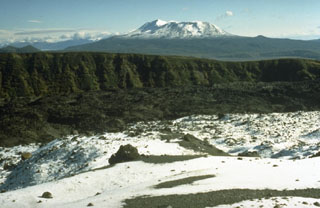 The eastern margin of Karymsky caldera, which was created about 7,500 years ago, forms the steep wall across the center of the photo. Fresh, dark-colored lava flows from Karymsky cover the caldera floor. The snow-covered volcano to the NE is Maly Semyachik, which has also produced frequent historical eruptions.
The eastern margin of Karymsky caldera, which was created about 7,500 years ago, forms the steep wall across the center of the photo. Fresh, dark-colored lava flows from Karymsky cover the caldera floor. The snow-covered volcano to the NE is Maly Semyachik, which has also produced frequent historical eruptions. Maly Semiachik, seen here from the SW on the flanks of Karymsky, is composed of three overlapping edifices along a NW-SE line that were built within two overlapping Pleistocene calderas. The late-Pleistocene to Holocene post-caldera massif almost completely obscures the rim of the inner 7-km-wide Maly Semiachik caldera.
Maly Semiachik, seen here from the SW on the flanks of Karymsky, is composed of three overlapping edifices along a NW-SE line that were built within two overlapping Pleistocene calderas. The late-Pleistocene to Holocene post-caldera massif almost completely obscures the rim of the inner 7-km-wide Maly Semiachik caldera. 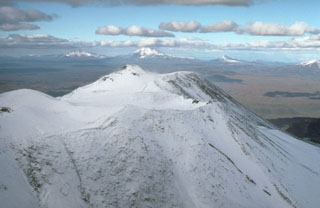 The summit of Paleo-Semyachik forms the highest point of the Maly Semyachik massif. Paleo-Semyachik, the first of three edifices constructed within two overlapping Pleistocene calderas, began forming about 20,000 years ago on the northern margin of the calderas. It produced lava flows that spread far beyond the caldera margins to the north and east before ceasing activity about 11,000 years ago. Activity then migrated to the SW, producing Meso-Semyachik volcano, whose flanks are in the foreground.
The summit of Paleo-Semyachik forms the highest point of the Maly Semyachik massif. Paleo-Semyachik, the first of three edifices constructed within two overlapping Pleistocene calderas, began forming about 20,000 years ago on the northern margin of the calderas. It produced lava flows that spread far beyond the caldera margins to the north and east before ceasing activity about 11,000 years ago. Activity then migrated to the SW, producing Meso-Semyachik volcano, whose flanks are in the foreground.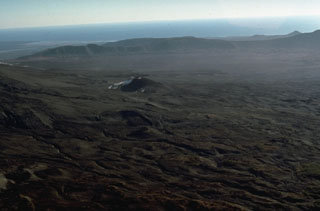 Volcanism along the elongated Maly Semiachik massif has progressively migrated to the south. The southern flank is mantled by Holocene cones and lava flows. The SE rim of a large Pleistocene caldera forms the low ridge in the background and the Pacific Ocean is visible in the distance.
Volcanism along the elongated Maly Semiachik massif has progressively migrated to the south. The southern flank is mantled by Holocene cones and lava flows. The SE rim of a large Pleistocene caldera forms the low ridge in the background and the Pacific Ocean is visible in the distance.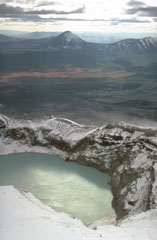 An acidic lake occupies Troitsky crater, the youngest and southernmost crater of Maly Semyachik where historical eruptions have occurred. The conical peak in the distance is Karymsky, 15 km SW, which was constructed within a Holocene caldera.
An acidic lake occupies Troitsky crater, the youngest and southernmost crater of Maly Semyachik where historical eruptions have occurred. The conical peak in the distance is Karymsky, 15 km SW, which was constructed within a Holocene caldera.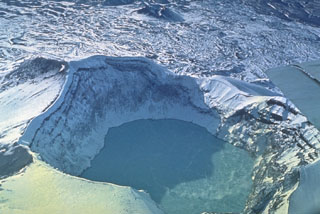 A crater lake fills Troitsky crater, the youngest of six craters capping the elongated summit of Maly Semiachik volcano in central Kamchatka. Steam rises from the surface of the hot, acidic crater lake in this early 1970s photo. The lake has a maximum depth of about 140 m. Temperatures as high as 41°C have been recorded, along with pH levels down to 0.4.
A crater lake fills Troitsky crater, the youngest of six craters capping the elongated summit of Maly Semiachik volcano in central Kamchatka. Steam rises from the surface of the hot, acidic crater lake in this early 1970s photo. The lake has a maximum depth of about 140 m. Temperatures as high as 41°C have been recorded, along with pH levels down to 0.4. Maly Semiachik is located within several nested Pleistocene calderas and composed of three overlapping edifices along a NE-SW line. Activity migrated to the SW, eventually forming the youngest cone, Ceno-Semiachik. It contains the historically active Troitsky crater, which formed during an explosive eruption about 400 years ago. It contains a hot, acidic lake this 1972 photo.
Maly Semiachik is located within several nested Pleistocene calderas and composed of three overlapping edifices along a NE-SW line. Activity migrated to the SW, eventually forming the youngest cone, Ceno-Semiachik. It contains the historically active Troitsky crater, which formed during an explosive eruption about 400 years ago. It contains a hot, acidic lake this 1972 photo. The currently active Troitsky crater of Maly Semiachik formed during an explosive eruption about 400 years ago. The eastern crater wall shows light-colored hydrothermally altered rocks of the vent complex that are overlain by darker lava flows and fall deposits from eruptions that followed formation of the crater. A hot, acidic lake now fills the crater, which has been the source of historical eruptions.
The currently active Troitsky crater of Maly Semiachik formed during an explosive eruption about 400 years ago. The eastern crater wall shows light-colored hydrothermally altered rocks of the vent complex that are overlain by darker lava flows and fall deposits from eruptions that followed formation of the crater. A hot, acidic lake now fills the crater, which has been the source of historical eruptions.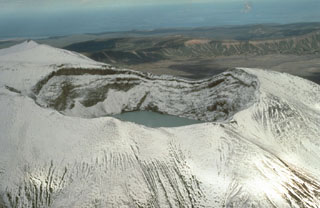 Troitsky crater, the youngest of six craters at the summit of Kamchatka's Maly Semyachik volcano, was formed during a major explosive eruption about 400 years ago. The crater, seen here from the W with the Pacific Ocean in the background, is at the summit of Ceno-Semyachik. This is the youngest of the four overlapping stratovolcanoes that comprise the Maly Semyachik massif. The crater is now filled by a hot, acidic lake and has been the source of historical eruptions.
Troitsky crater, the youngest of six craters at the summit of Kamchatka's Maly Semyachik volcano, was formed during a major explosive eruption about 400 years ago. The crater, seen here from the W with the Pacific Ocean in the background, is at the summit of Ceno-Semyachik. This is the youngest of the four overlapping stratovolcanoes that comprise the Maly Semyachik massif. The crater is now filled by a hot, acidic lake and has been the source of historical eruptions.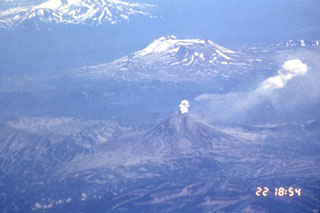 An aerial view from the SW on 22 July 1996 shows an ash plume rising above the summit crater of Karymsky with Maly Semyachik behind it. The 1996 eruption began on 2 January simultaneously with an eruption at nearby Akademia Nauk caldera, out of view to the right. The Akademia Nauk eruption lasted only a day, but long-term eruptions continued at Karymsky.
An aerial view from the SW on 22 July 1996 shows an ash plume rising above the summit crater of Karymsky with Maly Semyachik behind it. The 1996 eruption began on 2 January simultaneously with an eruption at nearby Akademia Nauk caldera, out of view to the right. The Akademia Nauk eruption lasted only a day, but long-term eruptions continued at Karymsky. Maps are not currently available due to technical issues.
There are no samples for Maly Semyachik in the Smithsonian's NMNH Department of Mineral Sciences Rock and Ore collection.
| Copernicus Browser | The Copernicus Browser replaced the Sentinel Hub Playground browser in 2023, to provide access to Earth observation archives from the Copernicus Data Space Ecosystem, the main distribution platform for data from the EU Copernicus missions. |
| MIROVA | Middle InfraRed Observation of Volcanic Activity (MIROVA) is a near real time volcanic hot-spot detection system based on the analysis of MODIS (Moderate Resolution Imaging Spectroradiometer) data. In particular, MIROVA uses the Middle InfraRed Radiation (MIR), measured over target volcanoes, in order to detect, locate and measure the heat radiation sourced from volcanic activity. |
| MODVOLC Thermal Alerts | Using infrared satellite Moderate Resolution Imaging Spectroradiometer (MODIS) data, scientists at the Hawai'i Institute of Geophysics and Planetology, University of Hawai'i, developed an automated system called MODVOLC to map thermal hot-spots in near real time. For each MODIS image, the algorithm automatically scans each 1 km pixel within it to check for high-temperature hot-spots. When one is found the date, time, location, and intensity are recorded. MODIS looks at every square km of the Earth every 48 hours, once during the day and once during the night, and the presence of two MODIS sensors in space allows at least four hot-spot observations every two days. Each day updated global maps are compiled to display the locations of all hot spots detected in the previous 24 hours. There is a drop-down list with volcano names which allow users to 'zoom-in' and examine the distribution of hot-spots at a variety of spatial scales. |
|
WOVOdat
Single Volcano View Temporal Evolution of Unrest Side by Side Volcanoes |
WOVOdat is a database of volcanic unrest; instrumentally and visually recorded changes in seismicity, ground deformation, gas emission, and other parameters from their normal baselines. It is sponsored by the World Organization of Volcano Observatories (WOVO) and presently hosted at the Earth Observatory of Singapore.
GVMID Data on Volcano Monitoring Infrastructure The Global Volcano Monitoring Infrastructure Database GVMID, is aimed at documenting and improving capabilities of volcano monitoring from the ground and space. GVMID should provide a snapshot and baseline view of the techniques and instrumentation that are in place at various volcanoes, which can be use by volcano observatories as reference to setup new monitoring system or improving networks at a specific volcano. These data will allow identification of what monitoring gaps exist, which can be then targeted by remote sensing infrastructure and future instrument deployments. |
| Volcanic Hazard Maps | The IAVCEI Commission on Volcanic Hazards and Risk has a Volcanic Hazard Maps database designed to serve as a resource for hazard mappers (or other interested parties) to explore how common issues in hazard map development have been addressed at different volcanoes, in different countries, for different hazards, and for different intended audiences. In addition to the comprehensive, searchable Volcanic Hazard Maps Database, this website contains information about diversity of volcanic hazard maps, illustrated using examples from the database. This site is for educational purposes related to volcanic hazard maps. Hazard maps found on this website should not be used for emergency purposes. For the most recent, official hazard map for a particular volcano, please seek out the proper institutional authorities on the matter. |
| IRIS seismic stations/networks | Incorporated Research Institutions for Seismology (IRIS) Data Services map showing the location of seismic stations from all available networks (permanent or temporary) within a radius of 0.18° (about 20 km at mid-latitudes) from the given location of Maly Semyachik. Users can customize a variety of filters and options in the left panel. Note that if there are no stations are known the map will default to show the entire world with a "No data matched request" error notice. |
| UNAVCO GPS/GNSS stations | Geodetic Data Services map from UNAVCO showing the location of GPS/GNSS stations from all available networks (permanent or temporary) within a radius of 20 km from the given location of Maly Semyachik. Users can customize the data search based on station or network names, location, and time window. Requires Adobe Flash Player. |
| DECADE Data | The DECADE portal, still in the developmental stage, serves as an example of the proposed interoperability between The Smithsonian Institution's Global Volcanism Program, the Mapping Gas Emissions (MaGa) Database, and the EarthChem Geochemical Portal. The Deep Earth Carbon Degassing (DECADE) initiative seeks to use new and established technologies to determine accurate global fluxes of volcanic CO2 to the atmosphere, but installing CO2 monitoring networks on 20 of the world's 150 most actively degassing volcanoes. The group uses related laboratory-based studies (direct gas sampling and analysis, melt inclusions) to provide new data for direct degassing of deep earth carbon to the atmosphere. |
| Large Eruptions of Maly Semyachik | Information about large Quaternary eruptions (VEI >= 4) is cataloged in the Large Magnitude Explosive Volcanic Eruptions (LaMEVE) database of the Volcano Global Risk Identification and Analysis Project (VOGRIPA). |
| EarthChem | EarthChem develops and maintains databases, software, and services that support the preservation, discovery, access and analysis of geochemical data, and facilitate their integration with the broad array of other available earth science parameters. EarthChem is operated by a joint team of disciplinary scientists, data scientists, data managers and information technology developers who are part of the NSF-funded data facility Integrated Earth Data Applications (IEDA). IEDA is a collaborative effort of EarthChem and the Marine Geoscience Data System (MGDS). |